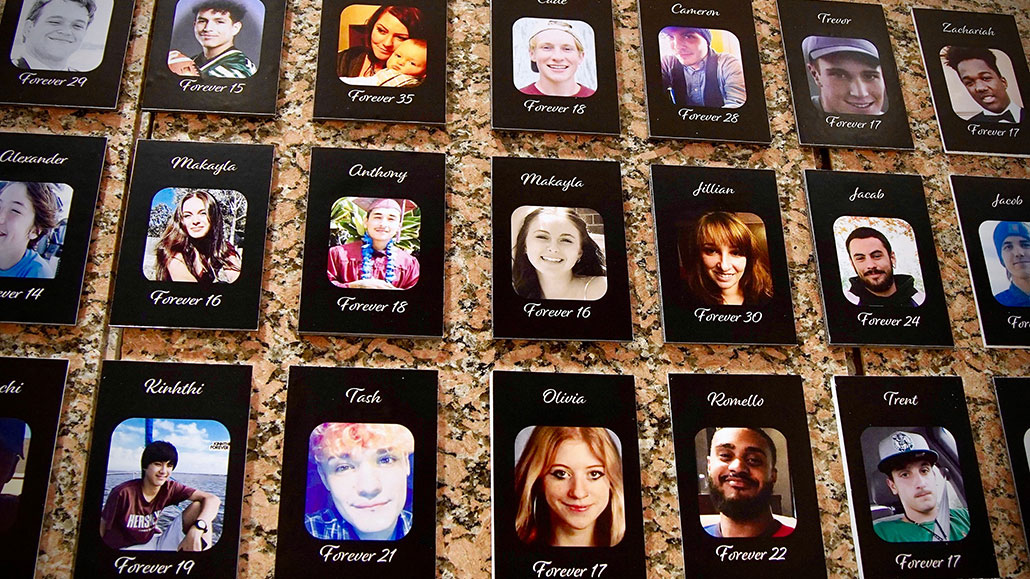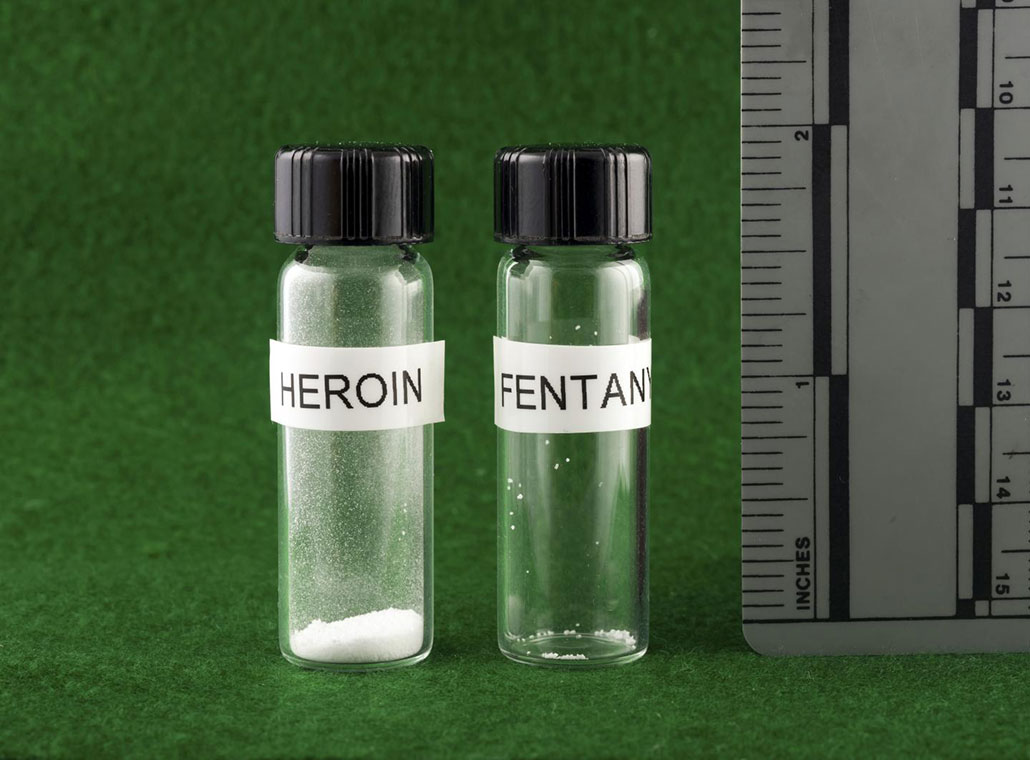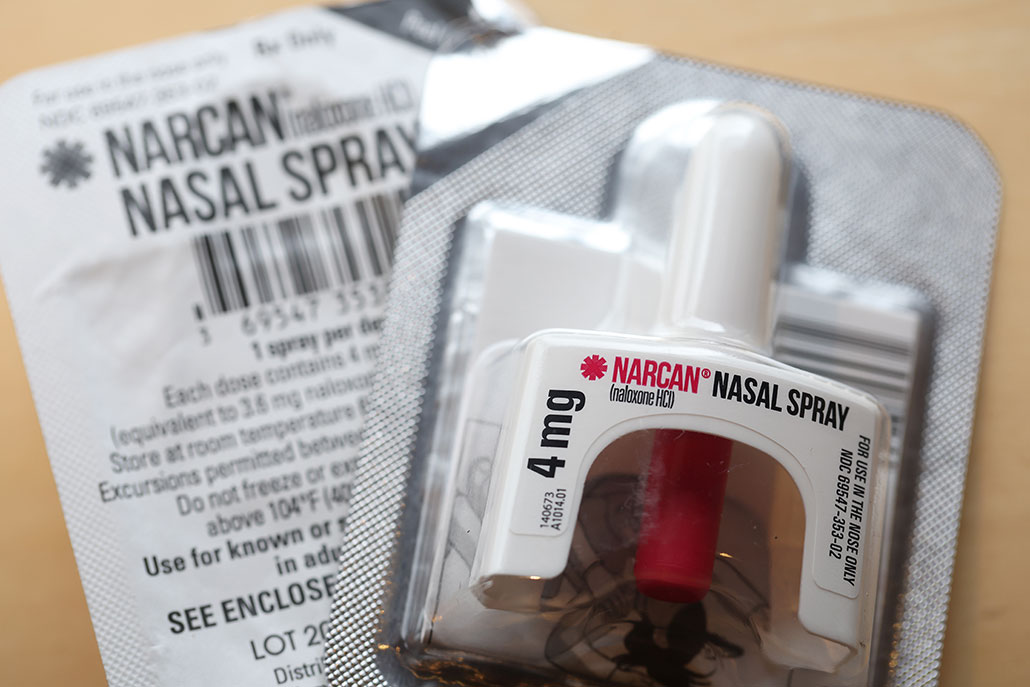Fentanyl deaths have spiked among U.S. kids and teens. Here’s what to know
A pediatrician explains how to avoid fentanyl and what to do in case of an overdose

Here’s a part of the “Faces of Fentanyl” wall at the U.S Drug Enforcement Administration headquarters in Arlington, Va. The photos put a face to many of the Americans who have died from fentanyl overdoses.
AGNES BUN/Contributor/Getty Images
The drug fentanyl is killing a growing number of U.S. kids and teens.
Doctors prescribe such opioids to patients with cancer and other conditions that cause severe pain. But some people also make and sell fentanyl illegally. In recent years, fentanyl has contaminated more and more illegal drugs. That’s dangerous, because fentanyl is about 30 to 50 times more potent than heroin, another opioid. As a result, even a very tiny amount of fentanyl can be deadly.
In 2021, more than 1,500 U.S. kids and teens died from fentanyl overdoses. That was far greater than the number of young people killed by other opioids that year. And it was four times as many fentanyl-related deaths as there were in 2018. Those findings appeared May 8 in JAMA Pediatrics.
Deadly trend
This chart shows how many kids and teens under age 20 have died from fentanyl each year, compared with how many died from other opioids. In 2017, deaths from fentanyl were more common than all other opioids put together. And fentanyl deaths among kids and teens have skyrocketed since then.
Science News Explores spoke with Sarah Bagley about the dangers of fentanyl. Bagley is a pediatrician and addiction-care provider at Boston University in Massachusetts. She explains how young people get exposed to this illegal drug, how they can avoid it and what to do in case of an overdose. (This interview has been edited for content and readability.)
How do young people encounter fentanyl?
Most young people are encountering fentanyl when they buy pills that they think are pain medications or stimulants (like Adderall), but actually contain fentanyl. In other words, most young people do not know they are at risk for being exposed to fentanyl. This kind of fentanyl is what we call “illicitly made fentanyl.” That means it was not produced by a pharmaceutical company. This is in this illegal market.
Teenagers think they are purchasing maybe Adderall or Percocet or oxycodone. Pills that contain fentanyl look really similar to [real] medications. But actually, what they’re buying is either all fentanyl — and it just looks like something else — or [the drug they meant to buy] has been made in a place where there was fentanyl (and now there’s fentanyl in the pill). Just one pill that you’re buying off the street can be enough to potentially cause an overdose.
Can pills be tested for fentanyl?
There are fentanyl test strips. [They work by] taking a tiny amount of the drugs that [someone’s] going to use and dissolving them in water. Then use what looks like a little COVID test to check to see if there’s fentanyl in it. You can’t buy [fentanyl test strips] at a pharmacy. You can order them online, though.
The one problem with it is what we call the “chocolate chip cookie effect.” Basically, you have this pill, and you test a tiny amount of it. Maybe the tiny amount that you tested didn’t have fentanyl in it. But that doesn’t mean there’s not fentanyl somewhere else in the pill. So, you still need to take other precautions.

How can young people protect themselves?
With the introduction of fentanyl into the drug supply, things are a lot riskier than they used to be. The safest thing to do is to not use [drugs] at all. Then your body is not even exposed to fentanyl. But if you’re going to [experiment with drugs] — or maybe are having a conversation with a friend who’s thinking about using drugs — there are some ways you can stay safer.
First, it’s important to recognize the signs of an overdose and to have naloxone on hand. Naloxone is a medication that can reverse the effects of fentanyl. It’s a nasal spray that is really easy to administer.
Second, we always definitely recommend that if you’re thinking about experimenting with drugs to make sure that there’s someone there with you. They would be able to call for help if there’s an emergency.
Third, we talk about the risks of mixing different kinds of drugs. We know that there is a higher risk of overdose when more than one kind of drug is involved. For example, mixing alcohol and fentanyl puts you at higher risk.
What does a fentanyl overdose look like?
An overdose is a life-threatening emergency. Here are some of the signs: Not responsive when you call or try to wake them up. Slowed breathing or no breathing. Maybe a gasping or gurgling sound. And the color of someone’s lips or their fingertips starts to become more purple or bluish-gray.

What should you do if someone might be overdosing on fentanyl?
Call 911. And then certainly if there is naloxone, you would want to administer it. There’s no age limit on who can use it. Teenagers can use naloxone.
Basically, the fentanyl goes to these receptors in your brain that affect breathing. They slow those or stop those from working. Naloxone can reverse that. It can revive someone and help them start to breathe again.
We’re really recommending to use it right away, if you’ve tried to get someone to respond and they’re not waking up. The best thing would be to give a dose of this naloxone immediately after calling for help.
How do you get naloxone?
You could ask your pediatrician or your healthcare provider for a prescription. In almost all states, you can [also] go to a pharmacy and ask a pharmacist to purchase naloxone. That’s called “behind-the-counter.” Later this summer, naloxone is going to be available over-the-counter, [meaning anyone can purchase it without a pharmacist’s help].
What else should young people know?
If you’re wondering about fentanyl or wondering about overdose, there is a lot of good information on the internet. But there can also be — like with everything — information that is not as reliable. So, they should definitely be asking the trusted adults in their lives to help them feel prepared to keep themselves and their friends safe.
Teens can find reliable online information about fentanyl and naloxone from the U.S. Centers for Disease Control and Prevention, the National Institutes of Health and Song for Charlie. Parents can learn more at drugfree.org.
This story includes reporting by Aimee Cunningham.







